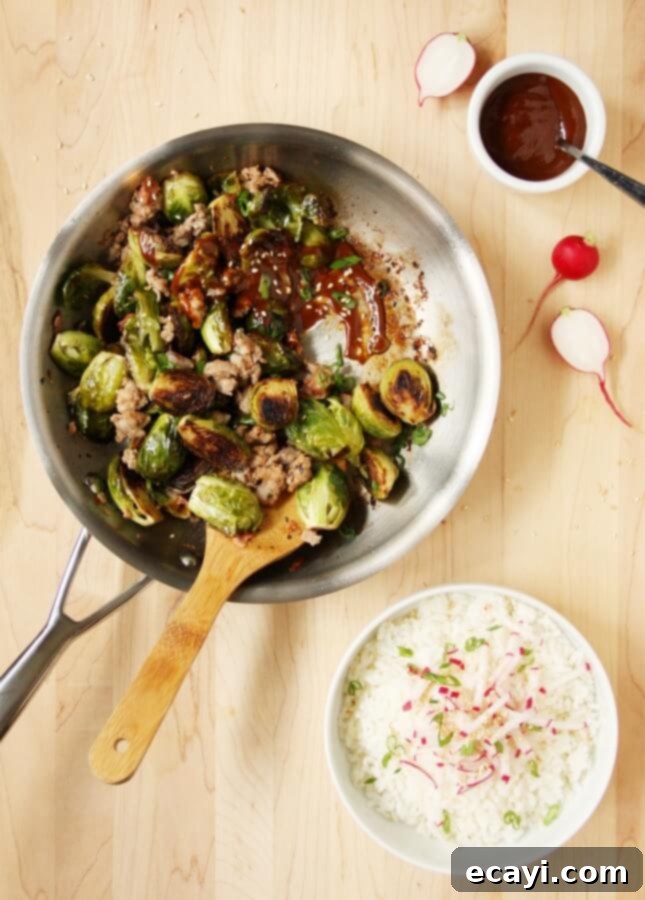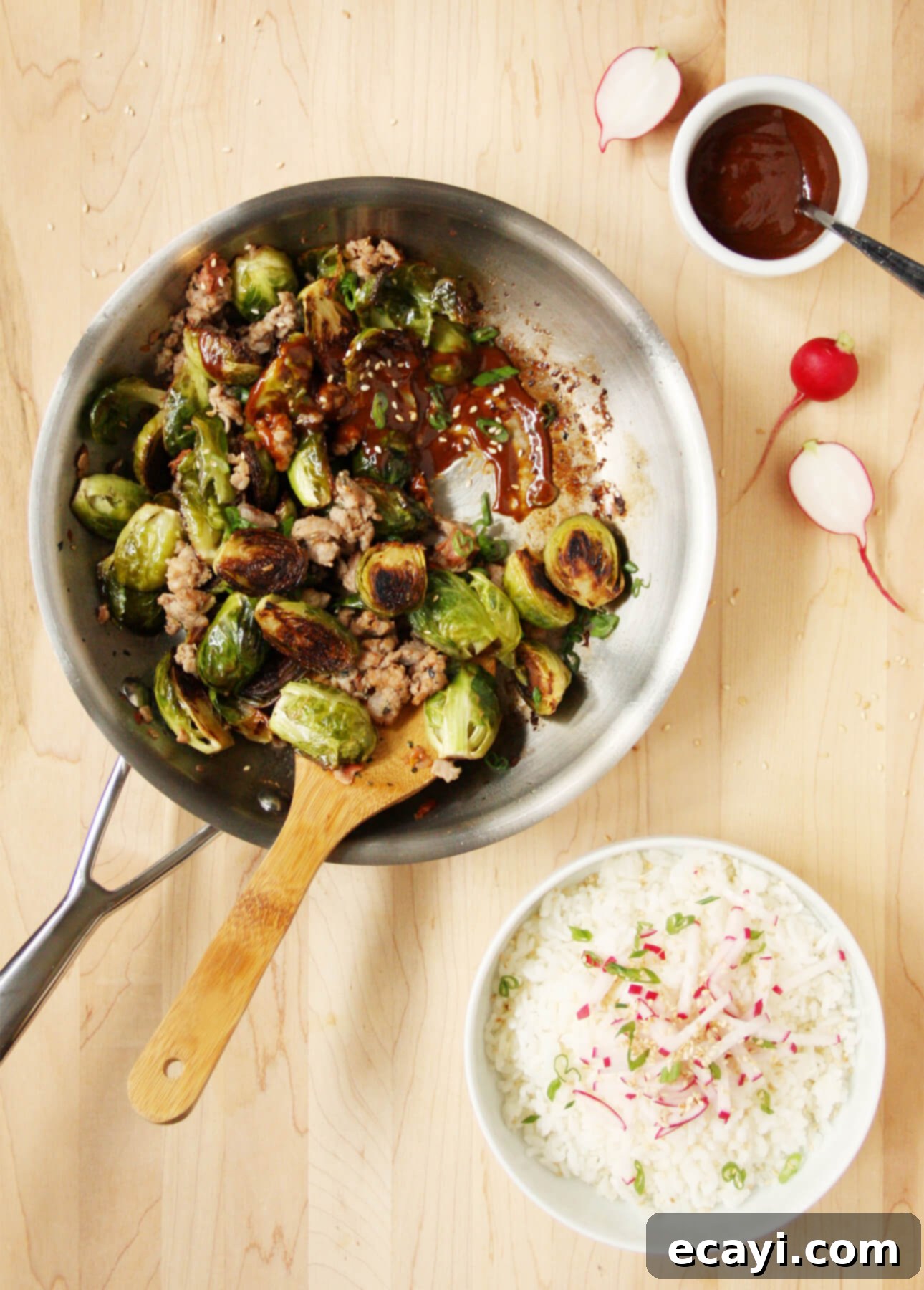Spicy Korean Roasted Brussels Sprouts & Sausage with Gochujang Sesame Sauce: A Flavorful Journey

Prepare to embark on a truly revelatory culinary adventure with what I confidently present as my recipe of the year. My deep-seated adoration for Korean spicy sauce began over a decade ago, ignited by a single, unforgettable bowl of bibimbap served during a Korean Air flight. Yes, you read that right—life-changing food can indeed be found at 30,000 feet!
This initial encounter sparked an obsession. After exhausting the precious bottles of sauce we meticulously brought back from South Korea, I once went to extraordinary lengths, spending a small fortune in duty fees to import more from the U.S. Why such dedication? Because back then, finding authentic Korean spicy sauce anywhere near my home, even through online Canadian retailers, was simply impossible. The particular sauce I favor, often labeled as a hot sauce for cold noodles or bibimbap, is a masterful blend of hot peppers, ripe tomatoes, fragrant garlic, rich sesame oil, tangy vinegar, and a touch of sugar. Its profile is distinctly spicy, subtly sweet, and wonderfully tangy, making it incredibly versatile. At its heart, it is essentially gochujang—the renowned Korean fermented chili paste—transformed into an irresistible, ready-to-use sauce sold in a convenient squeeze bottle. Much like others liberally apply ketchup or sriracha, I find myself drizzling this liquid gold on virtually everything.
The reason for my fervent praise of Korean spicy sauce today is its starring role in a newly discovered recipe that has completely captivated my taste buds, evoking the same sense of awe as my very first bibimbap. On the surface, the dish appears deceptively simple: perfectly roasted Brussels sprouts and savory fried sausage, generously coated in a vibrant spicy sauce and served warm over a bed of fluffy rice. Yet, the depth of flavor in that sauce—oh, the flavors! The harmonious combination of nutty sesame paste and umami-rich soy sauce with the Korean spicy sauce is so incredibly synergistic, it feels like an obvious pairing I should have concocted years ago. This ingenious blend creates an exceptionally versatile dressing that would be equally magnificent over a refreshing cold noodle salad as it is in this profoundly comforting and satisfying hot dish. It transforms humble ingredients into a truly extraordinary meal.
Unlocking the Flavors: Key Ingredients for Your Gochujang Sesame Sauce
Understanding the core components of this extraordinary sauce is crucial to achieving its signature taste. Here’s a closer look at the key ingredients:
A word about the ingredients used in the dressing: The specific bibimbap hot sauce brand I traditionally purchased was Ottogi, a reliable choice for authentic Korean flavor. However, I recently stumbled upon the Seriously Korean Bibim Gochujang sauce, and it has proven to be an equally delightful discovery, boasting a fantastic depth of flavor. If these specific bottled sauces are elusive in your local markets, fear not! You can easily substitute with traditional gochujang, which is generally more widely available in well-stocked Asian supermarkets or, conveniently, online. Remember, gochujang is a paste, so its consistency is thicker than a ready-made bibimbap sauce, but its flavor profile is the authentic heart of this dish.
I also incorporate Chinese sesame paste into this recipe. While similar in texture to tahini, the key difference lies in its preparation: it’s crafted from toasted rather than raw sesame seeds. This toasting process imparts a distinctly deeper, nuttier, and more robust flavor that truly elevates the sauce. It’s a staple in Asian supermarkets, but if your search proves unfruitful, regular tahini (made from raw sesame seeds) makes an excellent and readily available substitute. Just be aware that the flavor will be slightly milder. The combination of these ingredients creates a complex, savory, and subtly sweet sauce that perfectly complements the roasted vegetables and savory sausage, making this dish a truly unforgettable experience.
Spicy Roasted Brussels Sprouts and Sausage with Gochujang Sesame Sauce
This recipe brings together the crisp tenderness of roasted Brussels sprouts, the savory heartiness of sausage, and the vibrant kick of a gochujang-sesame sauce. It’s a balanced, flavorful, and incredibly satisfying meal that’s perfect for a weeknight dinner or a special occasion.
Serves 2
Ingredients:
- 3 tbsp (45 ml) canola oil, or other neutral tasting oil
- ¾ lbs (340 g) Brussels sprouts, cleaned and halved
- ¼ tsp (1 ml) kosher salt
- 2 raw sausage links, casings removed (substitute ground pork, chicken, or cubes of firm tofu for a vegetarian option)
For the Gochujang Sesame Sauce:
- 2 tbsp (30 ml) Japanese soy sauce (I use Kikkoman Lite soy sauce, which has 35% less sodium—if using a regular soy sauce, you might consider omitting the salt from the Brussels sprouts step above to balance sodium levels)
- 2 tbsp (30 ml) Chinese sesame paste, or tahini
- 1 tbsp (15 ml) bibimbap hot sauce, or gochujang (adjust to your preferred spice level)
- 1 tsp (5 ml) honey (to add a touch of sweetness and balance the spice)
To Serve (optional, but highly recommended for a complete experience):
- Cooked sticky rice (the perfect bed for absorbing all the delicious sauce)
- Radishes, cut into thin matchsticks (for a refreshing crunch and peppery bite)
- Green onions, thinly sliced (for a fresh, aromatic garnish)
- Toasted sesame seeds (for added nutty flavor and visual appeal)
Instructions:
- Prepare for Roasting: Begin by preheating your oven to a robust 400°F (200°C). This high temperature is key to achieving beautifully caramelized Brussels sprouts.
- Sear the Brussels Sprouts: In a large, non-stick, ovenproof skillet, pour 2 tbsp (30 ml) of the oil. Using a spatula, spread the oil evenly across the entire bottom of the skillet. Place the skillet over medium heat. Once the oil begins to shimmer, carefully add all the Brussels sprouts halves, ensuring their cut sides are placed down. Arrange them snugly to maximize contact with the hot surface (if your skillet isn’t large enough, it’s best to cook the sprouts in two separate batches to avoid overcrowding, which can lead to steaming instead of searing). Sprinkle the sprouts evenly with the kosher salt. Cook them undisturbed for 5 to 7 minutes, or until the cut bottoms are beautifully browned and caramelized. This initial sear develops incredible flavor and texture.
- Roast to Perfection: Gently stir the sprouts, allowing them to flip and move. It’s perfectly fine if some end up cut side down and others cut side up. If you cooked them in batches, now combine all the seared sprouts into a single skillet. Transfer the skillet to the middle rack of your preheated oven and roast for an additional 15 minutes, or until they are tender throughout with slightly crispy edges.
- Whisk the Gochujang Sesame Sauce: While the Brussels sprouts are roasting, prepare the star of the dish: the sauce. In a small bowl, whisk together all the sauce ingredients: Japanese soy sauce, Chinese sesame paste (or tahini), bibimbap hot sauce (or gochujang), and honey. You may find it helpful to slightly warm the sesame paste and honey beforehand, especially if they are very thick, to ensure they blend smoothly into a cohesive sauce. Set this flavorful mixture aside.
- Sauté the Sausage: Place another skillet over medium-high heat. Add the remaining 1 tbsp (15 ml) of oil. Once hot, add the sausage meat (casings removed, if applicable). Use a wooden spoon to break up the sausage into smaller pieces as it cooks. Sauté until the sausage is thoroughly browned and cooked through, ensuring no pink remains. Remove the skillet from the heat and keep the cooked sausage warm.
- Combine and Coat: Once the roasted Brussels sprouts are done, carefully transfer them from the oven to the skillet containing the sautéed sausage. Pour the vibrant gochujang sesame sauce generously over the sprouts and sausage. Stir everything together thoroughly, ensuring all the Brussels sprouts and sausage pieces are evenly coated in the rich, spicy sauce.
- Serve and Enjoy: Serve this sensational dish immediately over a bed of warm, sticky rice. For an added burst of freshness and texture, garnish with radish matchsticks, sliced green onions, and a sprinkle of toasted sesame seeds.
Tips for Success & Variations:
- Don’t Overcrowd: This is crucial for both the Brussels sprouts and sausage. Overcrowding leads to steaming rather than browning, resulting in less flavorful and crispy results.
- Spice Level Adjustment: The amount of bibimbap hot sauce or gochujang can be adjusted to your personal preference. Start with the recommended amount and add more if you desire extra heat.
- Protein Alternatives: While sausage is fantastic, feel free to experiment with other proteins. Cubed chicken breast or thighs, shrimp, or even firm tofu are excellent choices. Adjust cooking times accordingly.
- Add More Veggies: Bell peppers, mushrooms, or snap peas can be added to the roasting pan alongside the Brussels sprouts for extra nutrition and color.
- Make Ahead Sauce: The gochujang sesame sauce can be whisked together a day or two in advance and stored in an airtight container in the refrigerator, making meal prep even quicker.
- Serving Suggestions: Beyond sticky rice, this dish is also delicious served with quinoa, brown rice, or even as a filling for lettuce wraps.
Recipe Credit: This exquisite recipe is an adaptation of a brilliant creation by Molly Yeh, whose culinary inspirations continue to delight.
For your convenience, you can also download this recipe in PDF format to keep it handy in your kitchen.
